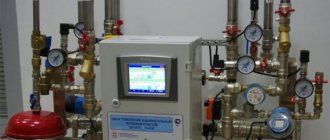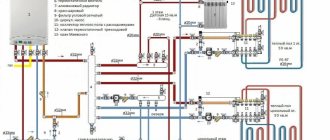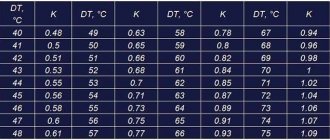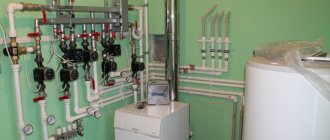It has long been possible to achieve a high level of automation of the smart home system. It controls almost everything: home infrastructure, security system, communications and computer network, entertainment devices and much more.
This article will only cover heating control. The reader will find out what the advantages and disadvantages of such a system are, which one is better to choose for a private house and a city apartment. He will also receive some additional installation tips.
Why you need to monitor the temperature in your home
In a smart home, the main task of heating is heating and temperature control. After all, you need to understand what will happen if it goes beyond the permissible limits (the optimal room temperature in the warm season is from 22 to 25 degrees, the temperature in the cold season is from 20 to 22 degrees).
Periodic hypothermia is dangerous for everyone. It leads to the development of acute respiratory diseases, disruption of the nervous system, and the appearance of “cold allergies” (in most cases with local skin rashes). In children's rooms, you need to especially carefully monitor the temperature, since the child is sensitive even to changes of a few degrees.
Overheating can also have unpleasant consequences. Firstly, high temperatures are favorable for the growth of bacteria and fungi (for example, mold). Secondly, it contributes to the appearance of general fatigue and increased fatigue. Thirdly, in case of prolonged exposure to elevated temperatures, water-salt metabolism may be disrupted. Fourthly, non-compliance with standards leads to overheating of equipment, the appearance of condensation and static charge at workstations.
Principle of operation
Some devices simply help maintain the required temperature and save money on it. More complex gadgets are given special algorithms of action. For example, they can automatically change the temperature regime, focusing on the owner’s preferences, day of the week and time of day (at night the temperature should be lower for good sleep, in the morning it should be higher to make it easier to get up for work/school).
Also, the boiler can turn on/off depending on the temperature outside, in the house or in a specific room. It is possible to turn it off remotely to save money and turn it on in advance, before coming into the house. This is especially convenient for large houses with an area of 150-200 square meters.
It is enough to configure the system via a computer or a special application on a smartphone.
Main components
The main heating components in a smart home are a boiler and radiators, sensors and pipes, thermostats and thermostatic heads, radiator valves and a controller. The functionality and composition of the system may vary depending on the model of devices and the method of their connection.
Listed below are additional items required for successful connection with the GSM controller, boiler and pads. If a smart home system is already installed, you need to think about the compatibility of devices with it.
Additional elements for connection:
- Temperature sensors. Their number will vary, but usually 2-3 pieces are enough.
- Gas leak detectors and smoke detectors. Their presence is optional, but very important for safety. So, when they are triggered, an alarm will sound, the gas will be shut off, the electricity will be turned off, and the smoke removal system will be started.
- Antenna for receiving a GSM signal, Ethernet cable or Wi-Fi adapter (depending on the controller).
- Access control device, such as an electronic key scanner. Not necessary, but it will help improve the safety of your smart heating.
- Battery to ensure autonomous operation of all system elements.
- Connecting wires and power cables.
Heated floors, fireplaces and other heating devices are also often used. You need to buy separate sensors and control modules for them.
Organization of heating control
In the Western market, there is a larger selection of programmers and controllers - but they usually do not have Russian localization.
Thermal conductivity of ceilings, partitions and walls, the quality of insulation in them, the implemented heating system and the method of heat distribution - these are all components of the climate inside a building. Radiators, “warm floors”, boilers, boilers play an important role here - this can be controlled using one control unit.
Controllers and programmers help configure the operation of any systems included in a “smart home”, and not just control home heating. Communication between all systems occurs through local units and executive relays, and their operation is monitored using sensors.
All components are in turn connected and configured in the main control unit. The list of systems that can be connected depends on the model and functionality of the latter.
Advantages and disadvantages
Owners of smart home heating note the following advantages:
- The temperature in the room will correspond to the set parameters, even if the owner has no time to monitor it.
- You can easily check the amount of energy consumed.
- Gas and electricity costs are significantly reduced. Data shows that the average smart home user saves about 30 percent during the heating season.
- The system instantly notifies the owner when device malfunctions are detected.
- It is possible to combine the operation of several heating devices and control them simultaneously.
Among the main disadvantages of such heating is its high cost. You can save a lot of money by doing everything yourself. But to do this you need to have the skills of one of the most qualified specialists in this field. After all, not every technician can handle installing already purchased devices and drawing up a diagram, and only a specialized specialist can carry out further configuration and performance testing. Accordingly, the same problems will arise if it is necessary to repair the system or replace its elements. To avoid this, it is necessary at the first stage to carefully consider the entire organization of work.
Turning on the heating at a certain time
You can set your arrival time in advance. This option impresses with its simplicity and low cost.
All we need from automation is a time relay. It is enough to install a timer in a circuit with an electric heater and set the required switching time.
I recommend: Do-it-yourself fire safety for a smart home
Let’s say, planning to arrive at the dacha at eight in the morning, we’ll set the relay to five. In three hours, the air in the house is guaranteed to warm up.
In order to save money, heating cannot be turned on in all rooms (unless, of course, your hacienda has only one room). Bringing the temperature in the living room and bathroom to +10 will be sufficient.
Even with a slight frost, this temperature will feel comfortable.
Modern time relay models can be installed even on an annual cycle
And in order not to waste electricity if the trip is disrupted, we will program the device to turn off the heating, for example, at lunch.
The disadvantage of this option is obvious - it is strictly time bound. Yes, and a good time relay with a programmable cycle for a month costs and is no longer so cheap.
Option No. 1: for a city apartment
Residents of apartment buildings need to take into account that the city infrastructure is already half automated. For example, there are heating units with a built-in mechanism for regulating the energy supply to the apartment, depending on the temperature outside.
You should also look at the general house coolant distribution scheme. If it has a sequential nature of switching on devices, it will not be possible to create a separate metering of energy consumption and independently regulate the process. There is only one way left - to install a jumper pipe and mount the automation. But this is quite difficult and expensive.
Those whose common house circuit allows parallel connection of conductors are more fortunate. For normal operation of the system, it is enough to buy the necessary components (including an indoor temperature sensor), turn on the thermostat on the coolant supply line. Control valves are built into the return pipe of heating devices. All this is connected to the controller.
Tips for selecting components and setting up system management
The right decision would be to order a turnkey “smart home” installation.
If you decide to integrate a control unit into the heating system, which will allow you to remotely configure its operation, then it is important which model will be purchased. Of those presented on the market, units of both zonal and local types are relevant. You can buy already assembled control units or purchase modules with relays that can be configured as programmers through official software. Ready-to-install controllers with a display, regulators and a set of modules have a higher price than modules with relays.
Athom Homey is the best model on the market, but it also has the highest price
It is important to immediately decide which protocols it will work with - not all devices can be integrated using Z-Wave or ZigBee standards. If it is not possible to understand the program code, then you should only buy ready-to-use, assembled “smart home” units. They work in different standards, but all are ready to use immediately after installation:
- Fibaro Home Center 2 – compatible with Google Assistant, has an Ethernet connection, works via the Z-Wave standard;
- RaZberry is an inexpensive device with limited functionality, works via the HomeKit standard, can be configured via a PC;
- VeraPlus is a multifunctional controller that works with most standards (including Z-Wave and ZigBee), user-friendly interface, easy setup via a computer and smartphone;
- Athom Homey is the best controller in terms of functionality, compatible with all standards (including integration with Alice), easy setup, support for all necessary protocols, but a very expensive model.
The range of boards with executive relays is much larger. These include the well-known “Arduino” module, the program code of which is in open sources and can be customized in accordance with user requests. A set of such modules can be combined into a single system, where remote control of both heating and other components of the smart home system will be carried out, to which any electrical appliances can be connected.
The smart home system can connect not only heating, but also ventilation, plumbing, lighting and other elements of a modern home that run on electricity
Programmers are fundamentally different - these are systems equipped with thermostats, thermometers, leakage and humidity sensors by default. They use from 1 to 16 circuits, which allows for precise control of heating.
Remote control systems are not relevant for use in centralized heating. In boiler rooms of apartment buildings, automation devices are used that control the temperature and turn off a certain pipeline or the entire boiler at the required levels. Programmers are suitable for these purposes; in the parameters you can enable SMS alerts, but control is carried out using knobs, buttons and a display.
Option No. 2: for a private house
In a private house, the owners are in no way limited in their capabilities, since they have their own heating system (most often from a boiler). But difficulties can still arise. After all, you will have to additionally install automation to the boiler in order to simplify the following processes:
- filling with fuel;
- control over combustion intensity;
- carrier circulation;
- control over temperature limits;
- setting the work timer.
In some cases, for a country house it is necessary to automate the entire boiler installation at once.
District heating control
In centralized heating, thermostats and thermostats of electronic and mechanical types are used.
Unlike installing a controller and relay in a private house, when installing centralized heating for an apartment building, the system will be different. In this case, it is necessary to connect sensors to each pipe, and the controller must provide autonomous heating, and not remote control. But via GSM or Ethernet, the control unit can transmit statistical data or information about the heating status.
A central heating system uses modules with specific relays, sensors and thermostats. Ethernet protocols and remote control are not needed here - automation according to preset parameters plays an important role in the DSP. The complexity of installing this equipment does not allow you to install it yourself - this should be done by a specialized specialist.
Types of smart home systems
A smart home system can be wired or wireless, centralized or decentralized. Below are the advantages and disadvantages of each type. The heating is compatible with any type of system, but the cost and installation method will vary.
Wired systems
In a wired smart home system, all sensors, sensors and other devices are connected with a special cable. This ensures their smooth operation, without any delays.
Wired systems have great functionality and the ability to integrate any gadgets into them, including heating ones. They do not require complex maintenance and are suitable for long-term use. Connected devices do not require additional power supplies, replacement batteries or accumulators.
However, this method is only suitable if the house is still under construction or being renovated. Otherwise, to install the cable hidden, you will need to completely dismantle the walls and floors.
You will also need to think in advance about where sockets and switches will be located.
Finally, you need to install, connect and configure the control unit. Naturally, such a large-scale project will require a lot of money, a lot of effort and energy to complete it.
Wireless systems
Today, most people choose wireless systems produced by Xiaomi, Redmon, Broadlink Zamel, HDL and many other brands.
In a wireless smart home system, devices connect to each other using a radio signal, Wi-Fi network or Bluetooth. The system has less functionality, but supports the operation of automated heating. Even a non-technical person can understand the settings. Cables are almost never used, so walls and floors remain intact. It is enough to outline where the detectors, sensors and other devices will be located approximately. Accordingly, the cost of such a project will be significantly lower.
Among the disadvantages, it is worth noting the need to change batteries and accumulators. Interference during signal transmission is also possible; this can be eliminated using a surge protector.
Centralized systems
In a centralized “smart home” system, control is carried out through one expensive controller with great functionality, its own operating system and all the necessary connectors. It collects and processes signals from all devices. This is convenient to use, since the owner of the house simply needs to enter the script.
But a centralized system cannot be called reliable. If the controller breaks, the entire system will not be able to function.
Decentralized (regional) systems
A decentralized (regional) smart home system is a complete contrast to a centralized one. So, several controllers are used (one for each room or one for each group of similar devices). They do not have their own operating system, but each of them is equipped with its own processor, memory and power source. Therefore, reliability is higher. If one device stops working, the rest of the system will continue to function.
The KNX protocol is used, which is used all over the world. If desired, it is possible to connect additional controllers to work with more complex, non-standard algorithms.
The disadvantage is that it is difficult to configure each device separately. There is also less functionality, but this will not affect the heating operation in any way.
You can learn more about KNX smart home, what it includes, how it is configured and how it works.
Remote control of the heating system
The ability to remotely configure heating network parameters is the main advantage of the complex.
All heating system controllers included in the “smart home” category are divided into two categories: local and zonal.
Local control units are systems that control the climate inside the house as a whole, regulating the operation of the entire heating system, including “warm floors”, radiators, boilers and zone heaters.
Zonal control units are devices that control the operation of a specific element of the heating system, for example, only “warm floors” or “boiler and radiators”. In both cases, the controllers can work with remote control, via GSM, Ethernet, Wi-Fi or other modules.
Via GSM unit
In units working with the GSM module, the ability to configure and change parameters using SMS messages is implemented. This is convenient for setting up without the Internet, but is considered a disadvantage due to the demands on the quality of the cellular network.
A controller in this category operates using GSM networks, so it must be used in accordance with the characteristics of the region, and can only be installed at a certain height.
Domestic heating system control units are no worse than Western ones, but they look less attractive.
GSM controllers for smart homes are being replaced by Ethernet modules on the market. Due to the complexity of setting up, local controllers are available with Internet connectivity. Zone modules can be used with the GSM protocol (for example, regulation and control of hot water entering radiators). Such controllers have a simple design, simple setup (via SMS), convenient control and an alert system.
The following types of models are suitable for zonal control:
- GSM-Thermometer “Telemetrics” - simple setup, 4 relays for control, convenient mobile application;
- GSM-Thermometer “Warm House 22” - presence of a display, several operating modes that can be switched by buttons or SMS, thermometers are connected by a telephone cable;
- TS2 GSM v6 – complex setup, but great functionality, ability to connect to the device via an application, convenient display;
- Climate ZONT-H1 GSM – inconvenient interface, setting parameters via the manufacturer’s website, working with 1 relay.
Most modern controllers have built-in GPS and Ethernet modules, which allows you to choose convenient control in certain conditions. The connection is made through circuits that are installed inside the heating system, and connected to the complex itself via a “relay”.
Ethernet
In the smart home system, heating can be controlled via the Internet connection. To do this, the installed control unit must have the appropriate module and support an Ethernet connection. Unlike GSM controllers, they allow several users to work through the software at once.
The list of gadgets available for connection depends on the software of the control unit and its firmware, as well as the model; most can work with smartphones, PCs, laptops and tablets. Another advantage is that setting parameters in such controllers is available anywhere in the world where there is Internet access.
Most modern programmers and controllers have built-in both GSM and Ethernet protocols
Unlike programmers and GSM controllers, control units with the ability to connect via the Internet have the following advantages:
- There is no limit on the number of users.
- You can configure settings by connecting to a network anywhere in the world.
- User-friendly interface.
- Possibility of integration with voice assistants “Google Assistant” or “Alice”.
- You can configure such controllers without the help of a specialist.
Since there is no link to the number, identification of the owner plays an important role in such blocks. Most people choose a PIN code as protection, but you can use voice identification, fingerprint or FaceID.
In domestic units that operate remotely via the Internet, an Arduino module is usually used, which can be adapted into any circuit for remote control. But you can also use other models with Internet relays.
Installation recommendations
Basic recommendations:
- It is necessary to use only high-quality equipment and contact trusted specialists. You shouldn't skimp on your safety.
- It is important to use filters; if they are missing, the work may be disrupted.
- You need to think in advance where the thermostats will be located. Ideally, there should be several of them (one in each room).
The development of technology helps to increase comfort and convenience, and simplify the performance of everyday tasks. One proof of this is the smart home heating system.
Now the user is familiar with its capabilities. He knows what steps need to be taken to install it in his country house or city apartment. All that remains is to purchase the necessary devices and contact a specialist.
Features of the arrangement of “smart” heating
The most important thing that can be classified as recommendations for installing thermal systems in a smart home is the use of high-quality control equipment, as well as reliable filters.
Effective filtration of the coolant flow and the use of reliable adjustment mechanisms contribute to the accurate and flawless operation of the system.
Even the most automated system will not be able to function normally without the presence of a familiar and simple element - a filter. This point should be taken into account when solving an automation problem.
Automated modules based on controllers provide a high degree of sensitivity and allow you to regulate processes with an accuracy of up to one percent.
However, in the absence of filter modules, the operation of the flow regulators may be disrupted after only a short period of operation.
It is recommended to technically correctly calculate and select the installation points of thermostats (sensors), since the correctly chosen installation location allows you to achieve the maximum effect of regulation as a whole. Information on effective placement points can always be found in the device data sheet.
Where to buy equipment
You can purchase smart heating equipment either in a specialized store or online in an online store. In the second case, the budget option for purchasing products on the Aliexpress website deserves special attention. For some lamps there is an option for shipment from a warehouse in the Russian Federation; they can be received as quickly as possible; to do this, when ordering, select “Delivery from the Russian Federation”
| Heating controller ZONT SMART 2.0 | Smart thermostat AVATTO Tuya with Wi-Fi | Smart radiator drive TRV ZigBee3.0 |
| Smart water heating controller | MoesHouse ZigBee Thermostat | Controller for gas boiler TUYA |










